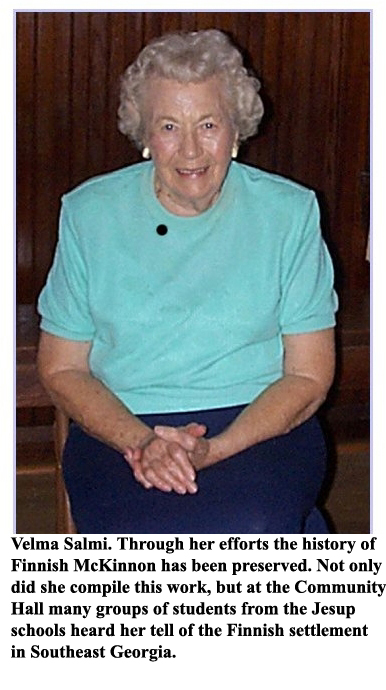In
early
1921
a
group
of
men
revelling
in
the
comfort of a Brooklyn, New York sauna discussed
the
prospect of coming to Southeast Georgia to form a
cooperative
farm. They were told that the weather
there was good for farming, so
they felt this could offer a challenge to postwar
depression from
World
War I. After advertising in Finnish newspapers,
money became
available for this purchase from
members of communities in New York,
Maine and Minnesota.
After
their
arrival
they
learned that a group of German people from Ohio had
purchased the
land to
raise dairy cattle but returned to Ohio when they
discovered
despite their hard labor, the business was
not profitable. At this
time the Finns also discovered they had been bilked
into purchasing
acreage at
$18.00 per acre which actually was selling for 50¢
to
80¢
an acre (or which had been sold for 50¢ to
80¢). After
planting
they also realized the ground was not "fruitful"
(or, very
fertile) and certainly not
worth the cost. No doubt the Finnish
"sisu" (perseverance, determination) encouraged them
to
stay and
do their best. They named it Fairfield Cooperative
Association... 100 members paying $550.00 per
share, one share per
family.
About
one-half
of the
membership families moved from the North and
Midwest. They brought
with
them a "Cut and Burn" method land clearing (Old
World
Custom) with stumps removed by mules. This
enabled them to begin
building their homes as well as planting their
crops. Each
shareholder was
entitled to one-half acre on which to build their
home and also a percentage of any cooperative
earnings.
One
of
the
first
buildings to be erected was the Boarding House for
the bachelors,
followed by: a
Community Sauna, the traditional Finnish steambath
--
heated every Wednesday and Saturday and
where fervent discussions
also took place -- a Company Store, Post Office and
the Social Hall,
which
was used for board meetings, cultural and
educational programs,
community socials and the
ever-popular Saturday night dance where
the young people learned the schotish, mazurka,
old-fashioned
waltzes, polkas and the local square dances.
Next
